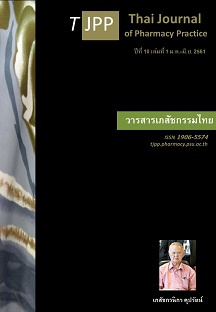การจำลองผลกระทบทางการเงินหากมีการปรับเปลี่ยนวิธีการเบิกจ่ายค่ายาสำหรับ ผู้ป่วยนอกในระบบประกันสุขภาพหลัก: กรณีศึกษาโรงพยาบาลทั่วไปแห่งหนึ่ง
Main Article Content
บทคัดย่อ
วัตถุประสงค์: เพื่อจำลองผลกระทบทางการเงินต่อผู้จ่ายเงินในระบบและผู้ให้บริการหากมีการใช้เกณฑ์การกำหนดราคาเบิกจ่ายค่ายาที่พัฒนาขึ้น โดยเทียบกับระบบการเบิกจ่ายปัจจุบันกรณีผู้ป่วยนอกในสิทธิสวัสดิการรักษาพยาบาลข้าราชการ สิทธิหลักประกันสุขภาพถ้วนหน้า และสิทธิประกันสังคม วิธีการ: การศึกษาใช้ข้อมูลการสั่งใช้ยาของผู้ป่วยนอกที่มารับบริการ ณ โรงพยาบาลทั่วไปแห่งหนึ่งระหว่าง 1 ตุลาคม พ.ศ. 2556 ถึง 30 กันยายน พ.ศ. 2557 หลังจากนั้นวิเคราะห์ผลกระทบทางการเงินโดยการจำลองสถานการณ์หากมีการเปลี่ยนวิธีการเบิกจ่ายค่ายา ตามรูปแบบทางเลือกที่มีการพัฒนาขึ้นและที่มีอยู่แล้ว ได้แก่ รูปแบบ RP-1 (เบิกจ่ายตามหลักเกณฑ์ราคาเบิกจ่ายค่ายาของกรมบัญชีกลาง) รูปแบบ RP-2 (เบิกจ่ายตามหลักเกณฑ์ราคาเบิกจ่ายค่ายาของสำนักงานหลักประกันสุขภาพเขต 13) และรูปแบบ RP-3 (เบิกจ่ายตามหลักเกณฑ์ราคาเบิกจ่ายค่ายาที่พัฒนาโดยสำนักงานวิจัยเพื่อการพัฒนาหลักประกันสุขภาพไทย) ผลการวิจัย: รูปแบบ RP-2 ทำให้ผู้จ่ายเงินในระบบประหยัดค่าใช้จ่ายด้านยาได้มากที่สุด โดยที่มูลค่าเบิกจ่ายไม่ต่ำกว่าต้นทุนค่ายาของโรงพยาบาล การเปลี่ยนรูปแบบการเบิกจ่ายค่ายาที่รวมอยู่ในอัตราเหมาจ่ายรายหัวในสิทธิหลักประกันสุขภาพถ้วนหน้า เป็นการเบิกจ่ายตามรายการทำให้ประหยัดค่าใช้จ่ายได้มากกว่าในกรณีผู้ป่วยนอกที่ขึ้นทะเบียนเป็นผู้มีสิทธิกับโรงพยาบาลที่ศึกษา โดยมีเงื่อนไขว่า อัตราการใช้บริการของผู้มีสิทธิต้องไม่สูงกว่าร้อยละ 66 และมีสัดส่วนอัตราเหมาจ่ายรายหัวสำหรับค่ายาไม่น้อยกว่าร้อยละ 68 สรุป: การใช้หลักเกณฑ์การกำหนดราคาเบิกจ่ายค่ายาที่พัฒนาขึ้นเมื่อเทียบกับหลักเกณฑ์การเบิกจ่ายปัจจุบันในผู้ป่วยสิทธิสวัสดิการรักษาพยาบาลข้าราชการจะช่วยให้ผู้จ่ายเงินในระบบสามารถประหยัดค่าใช้จ่ายด้านยาลงได้ ในขณะที่ผู้ป่วยสิทธิประกันสุขภาพที่มีรูปแบบการเบิกจ่ายแบบเหมาจ่ายรายหัวหรือสิทธิหลักประกันสุขภาพถ้วนหน้า ให้ผลการศึกษาที่แตกต่างกัน ขึ้นกับการกำหนดเพดานการตามจ่ายรายครั้งของการบริการ สัดส่วนผู้เข้ารับบริการ สัดส่วนค่ายาจากอัตราเหมาจ่ายที่ได้รับ ต้นทุนค่ายา และปริมาณการใช้ยาของผู้ป่วย
Article Details
ผลการวิจัยและความคิดเห็นที่ปรากฏในบทความถือเป็นความคิดเห็นและอยู่ในความรับผิดชอบของผู้นิพนธ์ มิใช่ความเห็นหรือความรับผิดชอบของกองบรรณาธิการ หรือคณะเภสัชศาสตร์ มหาวิทยาลัยสงขลานครินทร์ ทั้งนี้ไม่รวมความผิดพลาดอันเกิดจากการพิมพ์ บทความที่ได้รับการเผยแพร่โดยวารสารเภสัชกรรมไทยถือเป็นสิทธิ์ของวารสารฯ
เอกสารอ้างอิง
2. Nikomborirak D. Mechanism for taking care of health insurance systems to reduce disparities [online]. [cited Jan 16, 2016]. Available from: www.
Hfocus.org/database/2013/07/3943#sthash.Iz9c8pzp.dpuf.
3. Thaipublica. Looking into the budget of NHSO: spending capitated money inappropriately [online]. [cited Feb 11, 201]. Available from: thaipublica.org/ 2015/01/public-health-services-52/4.
4. Jindapol N, Kunupatham P, Theerasilp P, Kitikanna korn N. Crisis of health insurance under Thai Civil Servant Medical Benefit Scheme (CSMBS). Srina garind Medical Journal 2014;29:199-206.
5. Udomaksorn S, Kessomboon N, Ngorsuraches S, Sakulbumrungsil R, Kanchanaphibool I, Luangruan grong P, Sripanidkulchai K. Setting reimbursement prices for pharmaceuticals: Cases of outpatient referral, disability, accident, and emergency for Bangkok-region National Health Security Office. Journal of Health Systems Research 2014; 8: 307-19.
6. Health Insurance System Research Office. The proposed pharmaceutical reimbursement model being developed for those under the Civil Servant Medical Benefit Scheme. Health System Research Institute; 2014.
7. Limwattananon C, Limwattananon S, Pannarunothai S, Tangcharoensathien V. Analysis of practice vari ation due to payment methods across health insurance schemes. CDP Health report.Nonthaburi, International Health Policy Program, Ministry of Public Health; 2009.
8. Limwatananon S, Limwattananon C, Pannarunothai S. Cost and utilization of drugs prescribed for hospital-visited patients: impacts of universal health care coverage policy, Health Systems Research Institute; 2004.
9. Choonharas S. The situation of the Thai elderly 2008. Bangkok: Foundation of Thai Gerontology Research and Development institute, Ministry of Social Development and Human Security; 2009.


